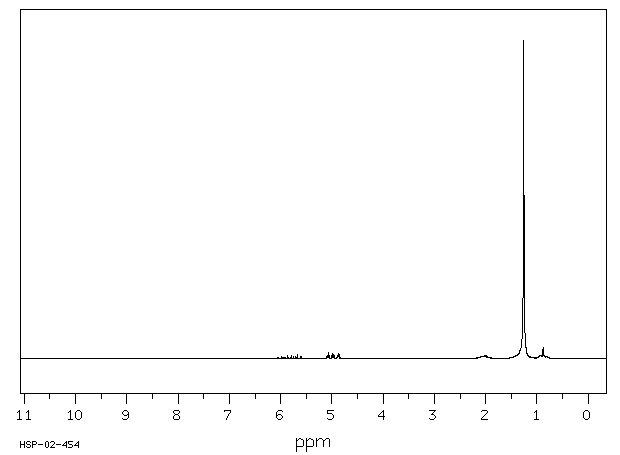1-二十二烯 | 1599-67-3
中文名称
1-二十二烯
中文别名
二十二碳烯;腺苷-5'-單磷酸
英文名称
1-docosene
英文别名
docosene;docos-1-ene;Docos-1-en;1‑docosene
CAS
1599-67-3;29730-67-4
化学式
C22H44
mdl
MFCD00027085
分子量
308.591
InChiKey
SPURMHFLEKVAAS-UHFFFAOYSA-N
BEILSTEIN
——
EINECS
——
-
物化性质
-
计算性质
-
ADMET
-
安全信息
-
SDS
-
制备方法与用途
-
上下游信息
-
文献信息
-
表征谱图
-
同类化合物
-
相关功能分类
-
相关结构分类
物化性质
-
熔点:65-72 °C(lit.)
-
沸点:180 °C0.22 mm Hg(lit.)
-
密度:0.7830 (estimate)
-
闪点:38 °C
-
溶解度:可溶于氯仿、乙酸乙酯(少量)
-
物理描述:Liquid
-
保留指数:2192;2195;2188;2191;2200;2189
计算性质
-
辛醇/水分配系数(LogP):12.2
-
重原子数:22
-
可旋转键数:19
-
环数:0.0
-
sp3杂化的碳原子比例:0.909
-
拓扑面积:0
-
氢给体数:0
-
氢受体数:0
安全信息
-
WGK Germany:-
-
RTECS号:JR1315000
-
海关编码:2901299090
-
安全说明:S23,S24/25
SDS
上下游信息
-
上游原料
中文名称 英文名称 CAS号 化学式 分子量 1-十二烯十二碳烯α-十二碳烯α-十二碳烯 1-dodecene 112-41-4 C12H24 168.323 -
下游产品
中文名称 英文名称 CAS号 化学式 分子量 —— (E)-21-dotetracontene 76665-59-3 C42H84 589.129
反应信息
-
作为反应物:参考文献:名称:Sustainable System for Hydrogenation Exploiting Energy Derived from Solar Light摘要:DOI:10.1021/jacs.0c13332
-
作为产物:参考文献:名称:DE583564摘要:公开号:
文献信息
-
Triethylborane-Induced Bromine Atom-Transfer Radical Addition in Aqueous Media: Study of the Solvent Effect on Radical Addition Reactions作者:Hideki Yorimitsu、Hiroshi Shinokubo、Seijiro Matsubara、Koichiro Oshima、Kiyoyuki Omoto、Hiroshi FujimotoDOI:10.1021/jo010652l日期:2001.11.1yield. The bromine atom-transfer radical addition in benzene was not satisfactory. The addition proceeded smoothly in polar solvents such as DMF and DMSO, protic solvents such as 2,2,2-trifluoroethanol and 1,1,1,3,3,3-hexafluoro-2-propanol, and aqueous media. Ab initio calculations were conducted to reveal the origin of the solvent effect of water in the addition reaction. The polar effect of solvents
-
Lewis acid assisted permanganate oxidations作者:Sheng Lai、Donald G. LeeDOI:10.1016/s0040-4020(02)01227-9日期:2002.12Lewis acids combine with permanganate in acetone solutions to form a complex that has enhanced oxidizing capabilities. The use of Lewis acids under these conditions to promote permanganate oxidations is superior to the use of Bronsted acids because the latter promote enolization of the solvent and subsequent unproductive reduction of the oxidant. The products obtained from a variety of alkenes, alkynes
-
Optically Active Monoacylglycerols: Synthesis and Assessment of Purity作者:Chao-Yuan Chen、Wei-Bo Han、Hui-Jun Chen、Yikang Wu、Po GaoDOI:10.1002/ejoc.201300247日期:2013.7Despite their simple structures, synthesis of 1(or 3)-acyl-sn-glycerols remains a challenge that cannot be ignored because of facile acyl migrations, which not only complicate the synthesis but also make direct GC or HPLC analysis unfeasible. Assessment of the optical purity of monoacylglycerols has, to date, relied almost exclusively on specific rotation data, which are small in value and thus insensitive
-
Ultrasonic assisted fabrication of dual function surface on PET and preparation of single component ink to attain efficient self-cleaning function via digital printing作者:Ramalingam Manivannan、Jiwon Ryu、Young-A SonDOI:10.1016/j.molliq.2020.114668日期:2021.2The self-cleaning effects of polyethylene terephthalate fabric (PET) through the photocatalytic effects of TiO2 (T), porphyrin (P) and silane (S) have been explored ultrasonically using bath type (WUC-D22H, Daihan Scientific, Korea). The ultrasonic power and frequency were 100 W and 30 kHz, respectively. The surface modification in fabric was achieved by the ultrasonic deposition of anatase TiO2 (T)使用浴液类型(WUC-D22H,Daihan Scientific,Korea)对超声波对TiO 2(T),卟啉(P)和硅烷(S)的光催化作用进行了研究,发现聚对苯二甲酸乙二酯织物(PET)的自清洁作用。超声功率和频率分别为100 W和30 kHz。超声沉积锐钛矿型TiO 2(T),卟啉(P),并通过硅烷(S)进一步改性实现了织物的表面改性。)被用来实现双重功能(光催化和超疏水)自清洁行为。通过可见光处理使各种有机污染物发生光致变色,证实了改性织物表面的染料降解能力。通过测试可见的各种染料,使用紫外可见光谱通过测量时间间隔改变后织物中浓度的变化来监测亚甲基蓝(MB)的分解。硅烷的附着及其在洗涤织物表面后的稳定性通过测量水接触角(WCA)来确认。自清洁效率依次为PET @ TP > PET @ TPS。修饰是在织物表面进行的,并通过XRD,XPS,UV-Vis和FESEM分析加以确认。织物的
-
Total Synthesis of the Echinodermatous Ganglioside LLG-3 Possessing the Biological Function of Promoting the Neurite Outgrowth作者:Yu-Fa Wu、Yow-Fu Tsai、Yuahn-Sieh Huang、Jing-Feng ShihDOI:10.1021/acs.orglett.0c02692日期:2020.10.2A total synthesis of echinodermatous ganglioside LLG-3 with neuritogenic activity was accomplished by a convergent strategy. The synthesis of 2-hydroxyethyl 8-O-Me-α-sialoside 2 was started from the phenyl 7,8-di-O-Pico-thiosialoside 5, which can be chemoselectively removed the picoloyl group, and then the methyl group in 8-O-MeNeu5Ac moiety was chemoselectively prepared using TMSCHN2/FeCl3. For preparation棘皮性神经节苷脂 LLG-3 具有神经元活性的全合成是通过收敛策略完成的。2-羟乙基8- O -Me-α-sialoside 2的合成是从苯基7,8- di- O -Pico-thiosialoside 5 开始的,它可以化学选择性地去除吡啶甲酰基,然后是8中的甲基- ø -MeNeu5Ac部分使用化学选择性TMSCHN制备2 /的FeCl 3。为了制备末端二唾液酸单元,我们小组最初利用氧化酰胺化来有效构建 8- O的 α(2,11) 键-Me-Neu5Acα(2,11)Neu5Gc。在此,我们还证明合成的神经节苷脂 LLG-3 表现出对初级皮质神经元的神经元活性,并且生物活性优于神经节苷脂 DSG-A。
表征谱图
-
氢谱1HNMR
-
质谱MS
-
碳谱13CNMR
-
红外IR
-
拉曼Raman
-
峰位数据
-
峰位匹配
-
表征信息
同类化合物
高密聚乙烯
香叶醇
顺式3-甲基-2-己烯
顺式-5-癸烯
顺式-5-甲基-2-己烯
顺式-5-庚烯-1-炔
顺式-4-癸烷
顺式-4-甲基-2-戊烯
顺式-4-甲基-2-戊烯
顺式-3-癸烯
顺式-3-甲基-3-己烯
顺式-3-甲基-2-庚烯
顺式-3-戊烯-1-炔
顺式-3,4-二甲基-3-己烯
顺式-3,4-二甲基-2-戊烯
顺式-3,4-二甲基-2-戊烯
顺式-2-甲基-3-己烯
顺式-2-壬烯
顺式-2-丁烯-D1
顺式-1.1.1-三甲基-2-丁烯
顺式-1-甲基-2-环丙基乙烯
顺式-1-甲基-2-乙烯基环戊烷
顺式-1-环戊基-1-辛烯
顺式-1-氘代-3-甲基-1-丁烯
顺式-(9ci)-2,3,3a,7a-四氢-4-(1-甲基乙基)-1H-茚
顺式-(2-丁烯基)环丙烷
顺式,顺式-2,4-己二烯
顺-环辛烯
顺-9-二十一碳烯
顺-6-十三碳烯
顺-5-甲基-1,3,6-庚三烯
顺-4-辛烯
顺-4-壬烯
顺-3-辛烯
顺-3-甲基-2-戊烯
顺-3-壬烯
顺-3-十三碳烯
顺-2-辛烯
顺-2-癸烯
顺-2-戊烯
顺-2-庚烯
顺-2-己烯
顺-2-丁烯
顺-2,2-二甲基-3-己烯
顺-1,3-戊二烯
顺,顺-1,9-环十六烷二烯
顺,顺,顺-环癸-1,3,5-三烯
间戊二烯
间二(4-吡啶基)苯
镁,二-2-丁烯基-










